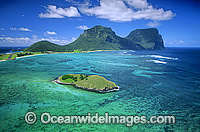
Aerial view of Lord Howe Island lagoon. |
|
My first glimpse of Middleton Reef
was from a high-flying aircraft chartered from Lord Howe
Island in 1989. Words could hardly describe its beauty.
The kidney shaped reef was fringed by a barrier of white
surf and looked like a floating opal in a vast ocean. The
exquisite colours and patterns captured my imagination and
I wondered about the underwater world that existed in the
surrounding blue water. Fortunately, during a photographic
shoot at Lord Howe Island the following year, I was able
to take part in an organised diving charter that was bound
for this jewel of the South Pacific.
Middleton Reef is a coral atoll that
is situated in a lonely ocean 120 nautical miles north of
Lord Howe Island. Like Lord Howe Island, its foundation
is a submerged seamount that sits on the western edge of
the Lord Howe Rise. The reef is flat, about 5km by 3km in
size, has a very large lagoon and is only exposed during
the period of low tide.
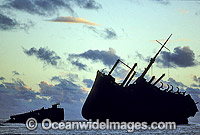
The wreck of the "Runic", high and
dry on the reef flat.
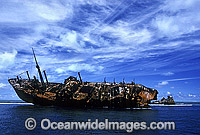 |
|
When approaching Middleton Reef by
boat, the first thing you see is the spectacular remains
of the “Runic”, a 13,587 ton ocean steamer that
sits high and dry on the reef in a upright position. She
was caught in a 1961 cyclone between Auckland and Brisbane
and came to grief on the reef’s north west side. The
whole stern section has broken completely away from the
main structure and stands separate, constantly reminding
visitors of the powerful seas that regularly pass through
the area. Since the time of European settlement in Australia,
many other unsuspecting ocean going vessels have fallen
victim to this treacherous reef.
When our charter boat, the “Capella
111”, arrived at Middleton, I couldn’t believe
our luck, conditions were perfect. This continued over the
next three days and we were able to dive anywhere around
the outside perimeter. We didn’t find any large gorgonian
fans or brightly coloured soft corals, but the fish life
was excellent and there was plenty of opportunity for photography.
Yellow flutemouth Aulostomus chinesnsis
tries to avoid detection amongst schooling
Blue-striped snapper Lutjanus kasmira.
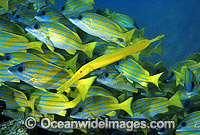
|
|
One shipwreck that we snorkelled was
unknown to us. She was completely broken up with her remains
scattered all over the sea floor. In the shallow gutters
of the surf zone were twisted lengths of metal with the
odd bronze porthole just sitting there. The sight of two
large anchors resting beneath the breaking waves had me
wondering of what must have been a horrifying moment when
the vessel struck the reef.
During an exploratory dive along the
northern perimeter, we came across a completely intact Japanese
long-liner tucked away in a protected area of reef only
12 metres beneath the surface. The spectacular fish live
in and around the wreck, including a family of large Black
Cod that were very friendly. Middleton Reef is probably
the last place where these magnificent fish can still be
seen in numbers. The species is very inquisitive which made
them easy targets for the spearfishermen of the 60’s
and 70’s, when they were almost completely wiped out
along the New South Wales coast. Today they are a totally
protected species.
Galapagos sharks
Carcharhinus galapagensis are extremely
common in the waters of Middleton Reef.
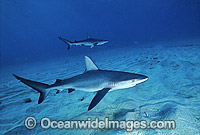 |
|
The Galapagos Shark Carcharhinus
galapagensis was also very common in these waters.
At the beginning of one particular dive, only minutes after
entering the water from the stern of the “Capella”,
a school of more that 20 of these sleek beauties cruised
in and circled us in a similar fashion to Barracuda. They
posed no threat, but their curious behaviour did seem strange.
No “chumming’ took place, they were just there.
During our diving we saw few tropical
fish species that we didn’t see at Lord Howe Island.
However, if a thorough marine photographic survey was conducted,
Middleton Reef could reveal many secrets.
Being situated a good distance further
north from Lord Howe Island, you would expect to see considerable
displays of coral, but this wasn’t so. The bottom
petered away from the reef crest gradually and we found
no big drop-offs close in. The huge ocean swells that normally
roll in, pound the reef’s outside perimeter and this
together with large numbers of Crown-of-thorns sea stars,
hardly allows for coral colonisation to take place. We saw
very few corals on the outside.
The protected area inside the lagoon
could be very different but unfortunately, a cyclone further
north had adverse weather heading our way and we were unable
to find out.
Black Cod Epinephelus daemelii.
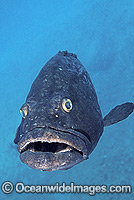
|
|
During a time of extreme weather conditions,
Middleton Reef is certainly the last place I would like
to get caught out. Although the lagoon does offer reasonable
protection, it would have been unwise to try and sit out
the weather, which may have taken a week or more. We decided
to high tail it out of there while the going was good and
make a run for the protected waters at Lord Howe Island.
About half way back, our nice calm area suddenly began to
turn into turmoil of giant ocean swells!
Back on Lord Howe Island, to the delight
of some ardent islanders, the huge swells continued to roll
in over the next seven days. Lord Howe Island had turned
into a mecca for surfers and for adventure seekers. With a telephoto lens fixed to
my camera, I sat on the beach and watched in awe.
Text: Gary Bell
Photography: Gary Bell
|

